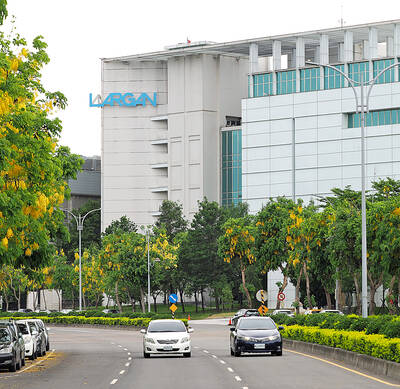China's September trade surplus unexpectedly sank to the smallest since April as the pace of export growth cooled. The decline may ease pressure on China to adopt a more flexible currency system.
The surplus was US$7.57 billion, down from US$10.6 billion in August, the Beijing-based customs bureau said on its Web site today. Exports rose 25.9 percent from a year earlier last month, down from 33.2 percent growth in August. The rate of increase in imports was 23.5 percent, the same the previous month.
The drop in the trade surplus may quell calls from China's trading partners for the yuan to appreciate more than it has under the trading mechanism adopted in July. US Treasury Secretary John Snow, who started an eight-day visit to China today, said he wants the country to adopt a more flexible currency trading system.
China's government bonds rose. The yield on the 10-year bond fell 6 basis points, or 0.06 percentage point, to 3.08 percent, a seven-month low. The price of the 4.44 percent bond maturing in February 2015 climbed 0.49, or 4.9 yuan per 1,000 yuan face amount, to 110.99. Bond yields move inversely to price.
China's trade surplus for the first nine months of the year was US$68.33 billion, compared with US$3.99 billion in the same period last year. Exports in the first nine months rose 31.3 percent to US$546.42 billion. Imports grew 16 percent to US$478.09 billion.
China on July 21 allowed its currency to appreciate for the first time in a decade, revaluing the yuan by 2.1 percent against the US dollar and replacing the pegged exchange rate with a link to a basket of currencies. Since the revaluation, the yuan has gained less than 0.3 percent against the dollar.
Snow and policy makers including European Central Bank President Jean-Claude Trichet will meet with Chinese Finance Minister Jin Renqing (
China's swelling trade surplus has been leading to rising trade tensions as countries around the world impose quotas and tariffs on Chinese-made goods now flooding their markets. The EU has already imposed quotas on exports of some Chinese textiles and said it would impose five-year tariffs on polyester fabrics from China. Brazil's Trade Ministry said on Sept. 30 it will investigate possible safeguard measures against rising imports of shoes, textiles and toys from China after talks between the two countries to limit shipments failed.
Central bank Governor Zhou Xiaochuan (
Surging exports from the world's biggest maker of mobile phones, clothes and steel have been helping to create jobs and sustain growth as government curbs on lending cool growth in investment, which last year accounted for nearly half of China's GDP. The economy expanded by more than 9 percent for the past eight quarters.

Taiwan’s foreign exchange reserves hit a record high at the end of last month, surpassing the US$600 billion mark for the first time, the central bank said yesterday. Last month, the country’s foreign exchange reserves rose US$5.51 billion from a month earlier to reach US$602.94 billion due to an increase in returns from the central bank’s portfolio management, the movement of other foreign currencies in the portfolio against the US dollar and the bank’s efforts to smooth the volatility of the New Taiwan dollar. Department of Foreign Exchange Director-General Eugene Tsai (蔡炯民)said a rate cut cycle launched by the US Federal Reserve

Handset camera lens maker Largan Precision Co (大立光) on Sunday reported a 6.71 percent year-on-year decline in revenue for the third quarter, despite revenue last month hitting the highest level in 11 months. Third-quarter revenue was NT$17.68 billion (US$581.2 million), compared with NT$18.95 billion a year earlier, the company said in a statement. The figure was in line with Yuanta Securities Investment Consulting Co’s (元大投顧) forecast of NT$17.9 billion, but missed the market consensus estimate of NT$18.97 billion. The third-quarter revenue was a 51.44 percent increase from NT$11.67 billion in the second quarter, as the quarter is usually the peak

The US government on Wednesday sanctioned more than two dozen companies in China, Turkey and the United Arab Emirates, including offshoots of a US chip firm, accusing the businesses of providing illicit support to Iran’s military or proxies. The US Department of Commerce included two subsidiaries of US-based chip distributor Arrow Electronics Inc (艾睿電子) on its so-called entity list published on the federal register for facilitating purchases by Iran’s proxies of US tech. Arrow spokesman John Hourigan said that the subsidiaries have been operating in full compliance with US export control regulations and his company is discussing with the US Bureau of

Pegatron Corp (和碩), a key assembler of Apple Inc’s iPhones, on Thursday reported a 12.3 percent year-on-year decline in revenue for last quarter to NT$257.86 billion (US$8.44 billion), but it expects revenue to improve in the second half on traditional holiday demand. The fourth quarter is usually the peak season for its communications products, a company official said on condition of anonymity. As Apple released its new iPhone 17 series early last month, sales in the communications segment rose sequentially last month, the official said. Shipments to Apple have been stable and in line with earlier expectations, they said. Pegatron shipped 2.4 million notebook